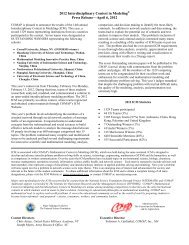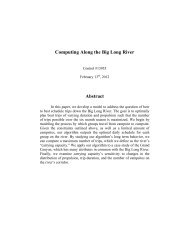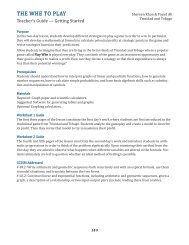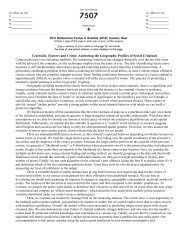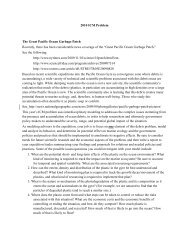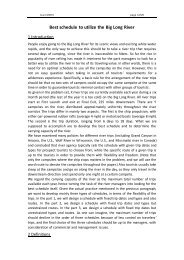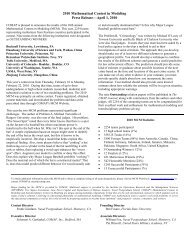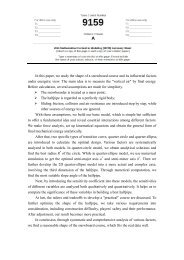FOR THE BIRDS
FOR THE BIRDS
FOR THE BIRDS
You also want an ePaper? Increase the reach of your titles
YUMPU automatically turns print PDFs into web optimized ePapers that Google loves.
<strong>FOR</strong> <strong>THE</strong> <strong>BIRDS</strong><br />
Teacher’s Guide — Extending the Model<br />
If you plot your data in question 2 to how full the bird feeder is as a function of time, you have three points:<br />
at time 0, it is full (y = 1); at 45 minutes, it is half full (y = 1/2 = 0.5); and your students probably discovered<br />
that it would be empty at 135 minutes (y = 0). So they have three points: (0, 1); (45, 0.5); and (135,0).<br />
What do you think happens between these points? You expect the birds to eat pretty steadily! So you connect<br />
(0, 1) and (45, 0.5) by a straight-line segment, and then (45, 0.5) and (135, 0) also by a straight-line<br />
segment. You have a function that is defined piecewise. So what would you expect to be the level of the bird<br />
feeder to have been at 18 minutes? Probably 0.8. What about at 1 hour and at 2 hours?<br />
Suppose you want the upper part of the feeder to empty in the same time as it took the lower part. How can<br />
you get it to do that, with the same number of birds involved in each part? One way is to put the upper<br />
perches closer to the top! Where should you put them? You should put them 1/3 of the way down, or you<br />
could fail to fill the bird feeder completely when you start. Neither the birds nor the scientists would like<br />
that. You can now play with different vertical distances among the rows of perches, and see what variety of<br />
patterns you can get.<br />
You have an interesting new question first: when do you think the bird feeder was originally filled? Proceeding<br />
as before you will again get a function defined-piecewise, but this time it will consist of three<br />
pieces. Why?<br />
Something more should be said about piecewise-defined functions. Such functions are seen much more<br />
often in modeling the outside world than is generally realized. Here are 3 more examples.<br />
(i) Post office functions. The simplest example is the postage for a letter as a function of its weight. Highly<br />
variable from year-to-year. Other rules, dealing with postage for packages, are more complicated.<br />
(ii) There was an ad for the price of turkeys at a supermarket the week before Thanksgiving. It said something<br />
like 89 cents a pound for birds under 8 pounds, 69 cents a pound between 8 and 14 pounds, and<br />
49 cents a pound above 14 pounds. What could you buy for 7 dollars? 8? 9? In the real world, you may<br />
not have all these choices. If you wait too long, you have to settle for whatever size is left.<br />
(iii) Look at the rpm of an automobile engine as the car starts and accelerates to cruising speed. When you<br />
shift from 1st to 2nd, you get onto a different curve and it happens again on the shift from 2nd to high.<br />
When shown this function, many students, even those in engineering schools, have trouble understanding<br />
what it represents. Jeff Griffiths from Cardiff, Wales was the source of this observation.<br />
Some of these functions are discontinuous, while others have discontinuous first derivatives. They are all<br />
defined piecewise, and they all model real situations.<br />
28







